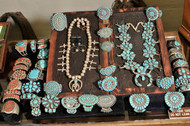Collector's Corner - Collecting for Investment
Posted by Jim Olson on Jun 26th 2020
Recently I was asked into the home of a Collector to assess their collection. These folks wanted to liquidate their items by sending them to auction. They had been collecting for years. They believed in the philosophy of putting their extra money into collectibles as an investment. They were now at a point in their lives where they wanted to sell the collection, buy an RV and travel. It was great hearing the enjoyment they had over the years of searching out and buying items for their collection. Auctions, yard sales, flea markets, crafts fairs, they were excited when relating the different stories of procurement.
Unfortunately the house was full of Bradford Exchange and Franklin Mint type of items, including hundreds of plates. They were especially excited about their “Native American” collection, which consisted of tourist type Navajo “Kachinas", low end split stitch baskets (along with import baskets) and dozens of signed prints by artists most people had never heard of. There were knock-off bronzes and mass produced statues made of pewter.
I do not judge anybody, and this kind of stuff is fine to buy if you want decorative items that do not cost much to decorate your home with. However, these types of “collectibles” are rarely a wise investment. They are decorative items, and home decor is rarely “collectible” or valuable later on.
I did not have the heart to tell them that in my opinion, they had not “collected well” as far as an investment goes and there was very little monetary value in the collection. And that the “tens of thousands” of dollars they thought they would get at an auction was actually a couple thousand dollars worth (at best) of yard sale or flea market items. I politely declined the consignment.
This little exchange got me to thinking—hence this month’s article.
I am a big proponent of collecting. I have always said it is nice to be surrounded by your savings accountable while enjoying it in your home, instead of having it all locked away in a bank somewhere. However, when collecting as an investment, we need to get educated on what we are doing! You would not (or should not) invest in the stock market, not having a clue as to how the stock market works. You should not invest in real estate blindly or buy it just because it is “cheap.” As a matter of fact, a wise investor does not invest in anything without having a good general knowledge of what he or she is investing in—and preferably also get some advice from an expert in the field.
An educated collector would not buy “collectibles” for investment that were made in China for a corporate giant. Or buy “crafts” from road-side vendors near points of interest for the tourists or buy spurs made in Japan from a western store. Remember, just because it was a “deal,” does not mean it was a good buy. There is “cheap” and there is “inexpensive.”
One of the first rules of buying as an investment is—don’t buy junk! Know the market on things you collect. If you collect coins, know what they are worth and which ones are practically worthless. If you collect stamps, know the market. If buying art is your thing, most knowledgeable collectors will advise you to stay away from prints (with very few exceptions).
If buying Native American arts and crafts, know that even though it may be “Native American made,” that does not necessarily mean it is a collectible, learn the difference between quality, handmade items and “crafts” which are hastily put together. Quality is quality, no matter who made it. Sure, buy certain items because you like them, that is perfectly ok, but do not think you are buying them as an “investment.” There is a difference between collecting just because in item pleases you and actually making a potential investment.
Another thing to realize is what you paid for an item does not usually matter when it comes to re-selling. Remember the markets can and will change. Know the current market.
Other basic things to remember when collecting for investment:
*Start small and collect what you like, but remember, quality is important.
*Things made to be collectible—rarely are. This includes pretty much all kinds of commemorative or mass produced items.
*Mass produced items do not necessarily just come from large companies. Check out most any gift shop for examples of crafts that are collectively mass produced by groups of people.
*But for sure, if your “collectible” says “Made in China” or “Made in Taiwan” on it — it’s not a collectible. It is a decor item, or a cheap knock-off.
*There is a difference between collectibles and decor. Decor is rarely collectible, but collectibles can sometimes make great decor.
*Things that have survived a long period of time and remain in good condition are often sought after.
*While condition is a big factor in value, restoration is generally not desirable.
*Rarity (or uniqueness) is usually a factor. Things whereby only a few have survived the test of time, or items that stand apart are generally sought after. If there are dozens of them that all look alike, be careful.
*Beware of fads in the market.
In another article published in this column, we talked about the basics of collecting. It was mentioned there are many other reasons to collect besides monitory ones. And that is true. There are many reasons to collect. However, when collecting as an investment, you should study the market. Know what you are dealing in like Warren Buffet does the stock market. Otherwise, it will be hit or miss whether you actually wind up with a good investment or not.
Jim Olson © 2020

